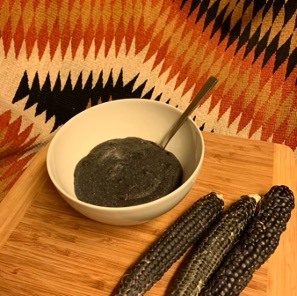Traditional Diné Blue Maize Mush
shared by Bill Robinson

This recipe and the story behind it are courtesy of Janine Yellowhair-Brown, a Diné who grew up in the tiny Navajo community of White Cone, in what used to be a Joint Use Area for the Navajo and the Hopi. The principle “joint use” was grazing sheep and goats. In 1974, however, Congress passed the Navajo/Hopi Land Settlement Act which resulted in the partitioning of the Joint Use Area. White Cone lost its best winter range, and all Federal grazing permits were canceled (Yurth: Oct. 2014). But Janine’s family has continued to graze both sheep and goats, though goats seem to predominate. Goats do better on forage without the lost rangeland. Yet despite the local importance of livestock, the traditional crops of maize, beans, and squash are still highly desired.
Janine says that blue maize mush is especially important to the Diné. It not only serves physical and spiritual functions, but it plays a key role in family and community hospitality. Not long ago, Janine had obtained a bag of blue cornmeal, part of an order delivered to the Nalwoodie Denzhone Apache Community at San Carlos by United Food Bank that had been processed and packed at the Crazy Chile Farm.
Not long after that Janine heard from her mother that her grandmother had become quite ill. So, she gave the bag to her mother in White Cone who promptly made a batch of blue maize mush for her ailing elder. The effect was astounding. Janine recounts it this way: “Mom said, my grandmother started feeling better immediately, and told her that the mush had restored peace and beauty to her spirit”, an effect that also points to the community importance of the dish. Blue maize mush is presented as a symbol of peace and wellbeing when the most esteemed guests arrive at a Diné home. Understandably, the guests regard the offering as a great honor.
INGREDIENTS

4 cups water
1 cup toasted blue cornmeal
1 tsp. juniper ash, to impart a deeper blue color
2 Tbsp. sweetener
Janine recommends honey, syrups, dried fruit and nuts, sugar, or turbinado. If serving with mutton stew, season with salt and pepper, rather than sweets. Stir often so the mush does not stick to the bottom of the pan.
Other options, or substitutions, are for the “dried fruit and nuts”, especially when some of the wild desert berries are in season and available for gathering. The most popular being any one of the three species of Wolfberry (Lyceum pallidum, L, Fremontii and L. excertum) found on the Navajo Nation. Wolfberry L. pallidum, known locally as rabbit thorn, is commonly found from 4,000 to 7,000 feet and is a prolific producer of 1/8 inch to ¼ inch sweet red and orange berries. There are seven other species that grow in other parts of the desert. They are wonderful in blue maize mush—if you can gather them before the birds eat them all. If the birds get them before you, or if you live in an urban area, frozen wild blueberries are a wonderful addition.
DIRECTIONS
- Begin by LIGHTLY toasting the blue cornmeal. This is best done by spreading out 1 cup of meal in a large, dry (no oil) frypan with the burner set at medium hot. Scrape and flip the meal frequently. When the meal begins to show some color change turn off the heat.
- Bring 2 cups of water to a boil.
- While the water is coming to a boil, add the following to a mixing bowl:
2 cups of cold water, 1 cup of toasted blue corn meal and 1 teaspoon of juniper ash.
When the ingredients are thoroughly mixed with the cold water and there are no lumps, add them to the boiling water. - Stir continuously until the water starts to boil again, then reduce the heat to a simmer. Cook for about 20 minutes, stirring often so the mush does not stick to the bottom of pan or so clumps do not form.
- Add sweetener of your choice: sugar, honey, syrups, dried fruit and nuts, wolfberries (if available) or blueberries.if you would prefer have it salty, you can add salt and pepper to enjoy the mush alongside a lamb and green chile stew.

